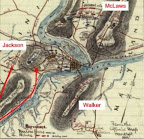Three weeks since my last post – please accept my apologies for such a long delay. I was busy preparing for Historicon, the largest historical miniatures wargaming convention in the USA. My other hobby is miniature wargaming and I also import several ranges of historical miniatures from the UK. Interestingly enough, I built a diorama of the action in the Forty Acre Cornfield at Antietam to display in my booth at the show. But enough on that – I may return to it later as a sidebar.
Tomorrow I leave for my annual Civil War weekend with my friend Matt, who has been touring battlefields with me since the early days. We are heading South, of course. The first stop is Bentonville, NC. I have purchased a copy of Mark Moore’s excellent guide and printed out full color maps for each tour stop from the battlefield web site. Time permitting (and the schedule is tight) we may get to Averasboro as well.
From North Carolina, we will head northeast to Newport News, Virginia. The Mariner’s Museum there houses the USS Monitor Center. Besides a full scale replica of the Monitor, the center contains many artifacts from the wreck of this most famous of ironclads, including a significant portion of the turret. Side excursions will include Gaines Mill, Glendale, and Malvern Hill as time allows.
On Sunday, we head west to Pamplin Park, located on the site of the April 2, 1865 breakthrough that shattered Lee’s Petersburg defenses and precipitated his retreat to Appomattox. Pamplin Park contains the National Museum of the Civil War Soldier, where visitors follow the experiences of a single soldier through the war and a series of interactive exhibits. The park also features a section of reconstructed works, including trenches and abatis, as well as several trails interpreting the site of the breakthrough.
On the way home, I hope to stop off at the North Anna Battlefield Park. This may be overly ambitious, but I am hopeful nonetheless. I expect this weekend to provide material for many posts in the weeks to come.
2 hours ago


